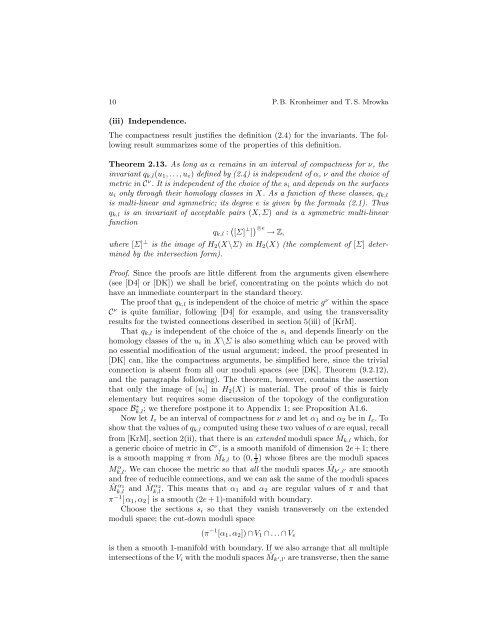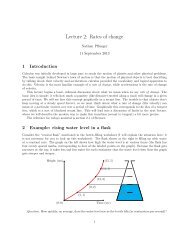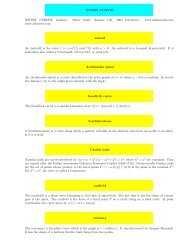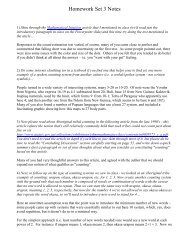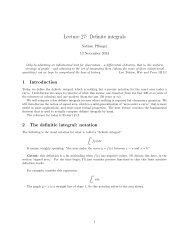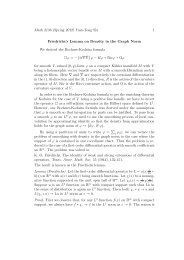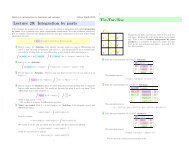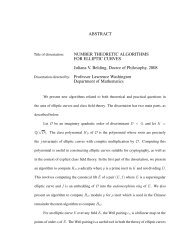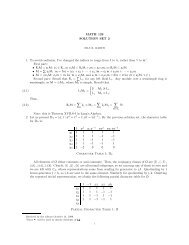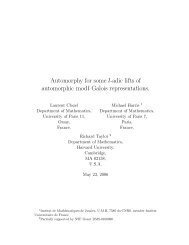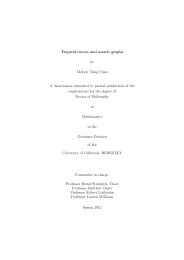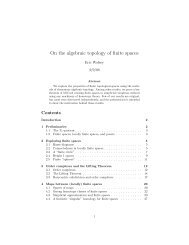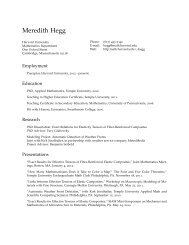Gauge theory for embedded surfaces, II
Gauge theory for embedded surfaces, II
Gauge theory for embedded surfaces, II
You also want an ePaper? Increase the reach of your titles
YUMPU automatically turns print PDFs into web optimized ePapers that Google loves.
10 P. B. Kronheimer and T. S. Mrowka<br />
(iii) Independence.<br />
The compactness result justifies the definition (2.4) <strong>for</strong> the invariants. The following<br />
result summarizes some of the properties of this definition.<br />
Theorem 2.13. As long as α remains in an interval of compactness <strong>for</strong> ν, the<br />
invariant qk,l(u1,...,ue) defined by (2.4) is independent of α, ν and the choice of<br />
metric in Cν . It is independent of the choice of the si and depends on the <strong>surfaces</strong><br />
ui only through their homology classes in X. As a function of these classes, qk,l<br />
is multi-linear and symmetric; its degree e is given by the <strong>for</strong>mula (2.1). Thus<br />
qk,l is an invariant of acceptable pairs (X,Σ) and is a symmetric multi-linear<br />
function<br />
qk,l : [Σ] ⊥ ] ⊗e → Z,<br />
where [Σ] ⊥ is the image of H2(X\Σ) in H2(X) (the complement of [Σ] determined<br />
by the intersection <strong>for</strong>m).<br />
Proof. Since the proofs are little different from the arguments given elsewhere<br />
(see [D4] or [DK]) we shall be brief, concentrating on the points which do not<br />
have an immediate counterpart in the standard <strong>theory</strong>.<br />
The proof that qk,l is independent of the choice of metric g ν within the space<br />
C ν is quite familiar, following [D4] <strong>for</strong> example, and using the transversality<br />
results <strong>for</strong> the twisted connections described in section 5(iii) of [KrM].<br />
That qk,l is independent of the choice of the si and depends linearly on the<br />
homology classes of the ui in X\Σ is also something which can be proved with<br />
no essential modification of the usual argument; indeed, the proof presented in<br />
[DK] can, like the compactness arguments, be simplified here, since the trivial<br />
connection is absent from all our moduli spaces (see [DK], Theorem (9.2.12),<br />
and the paragraphs following). The theorem, however, contains the assertion<br />
that only the image of [ui] inH2(X) is material. The proof of this is fairly<br />
elementary but requires some discussion of the topology of the configuration<br />
space B∗ k,l ; we there<strong>for</strong>e postpone it to Appendix 1; see Proposition A1.6.<br />
Now let Iε be an interval of compactness <strong>for</strong> ν and let α1 and α2 be in Iε. To<br />
show that the values of qk,l computed using these two values of α are equal, recall<br />
from [KrM], section 2(ii), that there is an extended moduli space ˆ Mk,l which, <strong>for</strong><br />
a generic choice of metric in Cν , is a smooth manifold of dimension 2e +1; there<br />
) whose fibres are the moduli spaces<br />
is a smooth mapping π from ˆ Mk,l to (0, 1<br />
2<br />
M α k,l . We can choose the metric so that all the moduli spaces ˆ Mk ′ ,l ′ are smooth<br />
and free of reducible connections, and we can ask the same of the moduli spaces<br />
ˆM α1<br />
k,l and ˆ M α2<br />
k,l . This means that α1 and α2 are regular values of π and that<br />
π −1 [ α1,α2] is a smooth (2e + 1)-manifold with boundary.<br />
Choose the sections si so that they vanish transversely on the extended<br />
moduli space; the cut-down moduli space<br />
(π −1 [α1,α2]) ∩ V1 ∩ ...∩Ve<br />
is then a smooth 1-manifold with boundary. If we also arrange that all multiple<br />
intersections of the Vi with the moduli spaces ˆ Mk ′ ,l ′ are transverse, then the same


